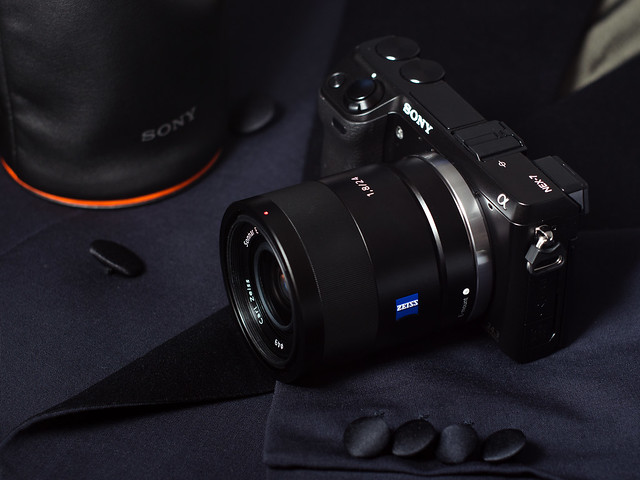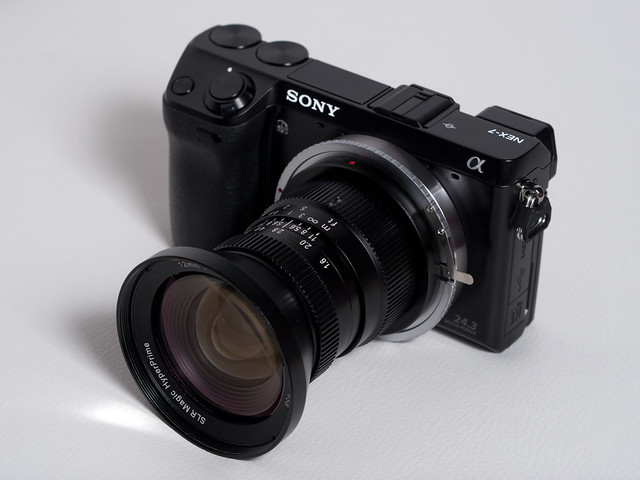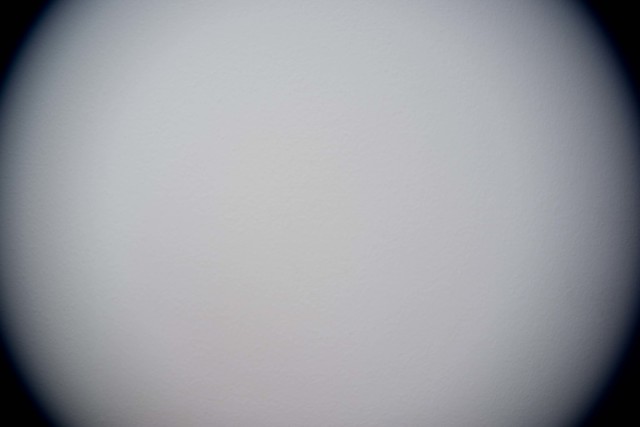In December 2011, when Sony's NEX-7 appeared on the market, it defined a new level of image quality for the next generation of mirrorless system cameras. With it's new 24 million pixel sensor that is able to support a dynamic range of about 13 EVs it is able to help you create images with an awesome image quality. But at the moment there are two main drawbacks: Very limited availabilty due to the Thai flood that still lowers production capacity and limited availability of high quality lenses like the Carl Zeiss Sonnar 24mm/F1.8 that support this extremely high resolution on an APS-C sized sensor natively.

Sony NEX-7 with Carl Zeiss Sonnar 24mm / F1.8
Especially in the wide angle range, Sony currently provides only one E-mount lens, the 16mm / F2.8 pancake, that shows quite limited support for the high sharpness and contrast demands of the new NEX-7 sensor. Since that and motivated by the small flange back distance, users are intensively looking for manual lenses in order to adapt them to Sony's E-mount. When first samples were revied and tested with super- and ultra-wideangle lenses of other systems, e.g. Voigtlanders 12 and 15 mm UltraWide Heliar for Leica M-mount, more and more people reported colorshifts at the borders that required black/white conversion or cumbersome postprocessing with tools like Cornerfix. The main reason for that disadvantage is the symmetric design, that you find typically for lenses intended to be used with analog film. It diffracts and delivers the light rays in a flat angle to the sensor causing these shifts on sensors that do not counteract with microlenses like found in the the NEX-5N. Currently this seems to be a big hurdle for large sensors with little pixel pitch mounted in a relatively flat body. Leica M9 users know this problem as well from some of the ultra wide angle M-mount lenses.
So, when looking for wide angle lenses with a more telecentric design, I thought about testing the SLR Magic HyperPrime 12mm F/1.6 that was able to provide a rich set of benefits to the MicroFourThirds (m4/3) system (look here for the article) on the NEX-7. Due to the smaller flange back distance of the E-mount, it is physically no problem to adapt also m4/3 lenses to a NEX as long as the lens controls (focus, aperture) can also be operated manually. The following picture shows the wide angle HyperPrime attached to the NEX-7:

As expected, the image circle of this m4/3 lens does not cover the whole APS-C sensor format. But the shadowing effect is less than expected as you can see in the following example taken at F2.0:

- The good news: Due to the telecentric construction of that lens, I did notice nearly no colorshift.
- The bad news: The adapter that I used for testing does not fullfill it's duty - the lens can not be focused infinite
I asked some other vendors of those m4/3-to-NEX-adapters if their product does a better job but they confirmed that problem as well. The correct flange back difference between MicroFourThirds and E-mount seems to be well kept secret. I only found one blog entry on the internet of someone who built an adapter on his own after making the same frustrating experience. So come on, adapter manufacturers: Yes, you can - PLEASE manufacture adapters that REALLY WORK as expected!
At open aperture, I could focus with the wide angle HyperPrime only up to about 50 cm. At least, this allows you to use that lens for some of it's most unique application areas: Sharp, nearly macro like close-ups flowing into a wide and smooth background with nice bokeh at available light. This is only possible due to it's very small minimum focus distance of 15cm (measured from the sensor surface) combined with a wide open aperture.
The following examples taken at F2.0 show it's potential. The have only minor image processing (some vignette reduction typically applied for uncorrected lens at open aperture) and are not cropped except the third:
(Click images for other sizes)
As soon as I find a better adapter, there will be an update to this article showing the results.
All images copyright by 3D-Kraft.com.







